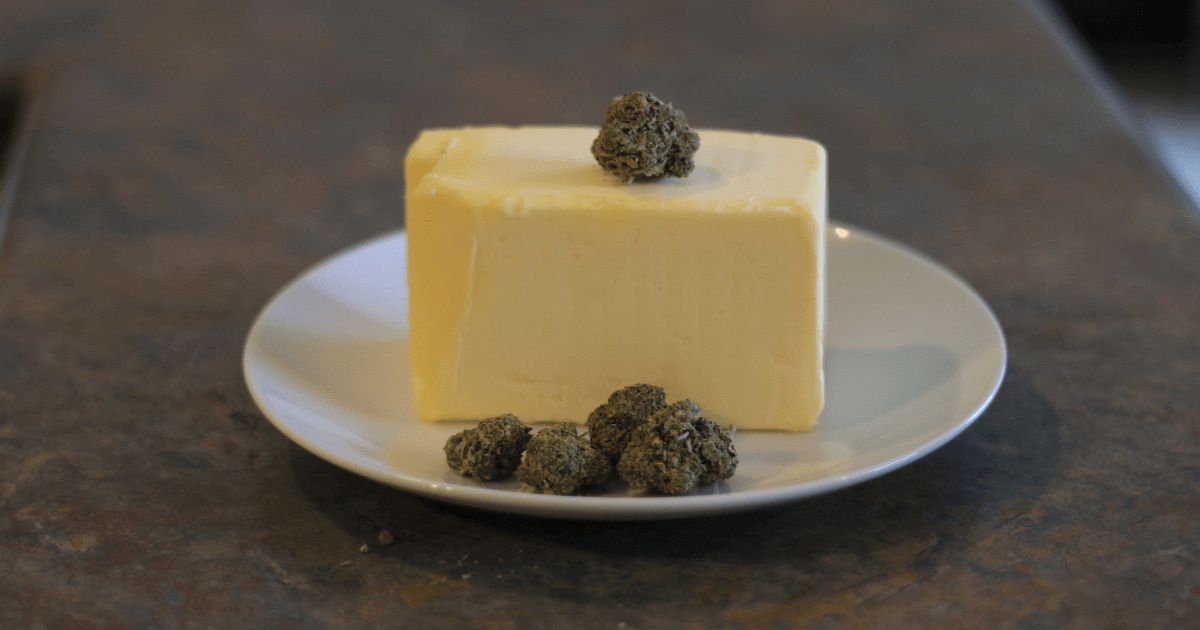Introduction to Cannabis Butter
Cannabis butter, also known as canna butter or marijuana butter, is a homemade concoction infused with the medicinal and psychoactive properties of cannabis. It is a versatile ingredient that has gained popularity among cannabis enthusiasts and culinary enthusiasts alike. The process of creating cannabis butter involves combining butter and cannabis, allowing the butter to absorb the cannabinoids, such as THC (tetrahydrocannabinol) and CBD (cannabidiol), from the plant material. This infusion results in a potent and flavorful butter that can be used in a wide range of recipes, from sweet treats like cookies and brownies to savoury dishes like pasta and sauces. It will let you make your own edibles like those found at Edibles Canada.
Cannabis butter provides a convenient way to incorporate the benefits of cannabis into edible creations. It allows individuals to control the dosage and experience the therapeutic effects of cannabinoids in a discreet and enjoyable manner. Whether you’re seeking relief from pain and inflammation or simply looking to explore the culinary possibilities of cannabis, cannabis butter opens up a world of creative opportunities. However, it’s important to note that when using cannabis butter, it’s crucial to understand the potency and dose accordingly to ensure a safe and enjoyable experience.
Benefits of Marijuana Butter
Marijuana butter, also known as cannabutter, offers several potential benefits for those who use it.
Here are some of the key benefits associated with marijuana butter:
- Therapeutic Effects: Marijuana butter contains cannabinoids, such as THC and CBD, which have been found to have various therapeutic properties. THC is known for its psychoactive effects, providing relaxation, euphoria, and pain relief. CBD, on the other hand, offers non-psychoactive benefits, including anti-inflammatory, analgesic, and anxiolytic effects. When infused into butter, these cannabinoids can be used to create edibles that provide therapeutic relief for conditions such as chronic pain, anxiety, insomnia, and more.
- Versatility: Marijuana butter can be used as a versatile ingredient in cooking and baking. It allows you to incorporate the benefits of cannabis into a wide range of recipes, from sweet treats like brownies and cookies to savoury dishes like pasta and sauces. This versatility allows individuals to explore their culinary creativity while enjoying the effects of marijuana.
- Discreet Consumption: Edibles made with marijuana butter offers a discreet way to consume cannabis. Unlike smoking or vaping, which can produce noticeable odours and smoke, consuming edibles allows for a more subtle and private experience. This can be particularly beneficial for individuals who prefer a more discreet method of cannabis consumption.
- Long-lasting Effects: When marijuana is ingested in the form of edibles, the effects tend to last longer compared to other methods of consumption, such as smoking. This is because the cannabinoids are metabolized by the liver, resulting in a slower release and prolonged duration of effects. This can be advantageous for those seeking sustained relief from symptoms or those looking for a longer, more relaxing experience.
- Precise Dosing: Making marijuana butter at home allows you to have control over the dosage of cannabinoids in your edibles. By calculating the amount of cannabis used and the potency of the butter, you can achieve more accurate and consistent dosing, ensuring a more predictable and controlled experience.
It’s important to note that individual experiences may vary, and the effects of marijuana butter can depend on factors such as the strain of cannabis used, the dosage, and personal tolerance. It’s always advisable to start with a low dose and gradually increase as needed while monitoring your body’s response.
How is Weed Butter Made?
Making weed butter, also known as cannabis butter or cannabutter, involves a relatively straightforward process.
Here’s a general step-by-step guide:
Ingredients and equipment you will need:
- 1 cup (2 sticks) of unsalted butter
- 7-10 grams of decarboxylated cannabis flower (ground or finely chopped)
- Medium-sized saucepan
- Cheesecloth or fine-mesh strainer
- Airtight container for storing the butter
Step 1: Decarboxylation
- Preheat your oven to around 240°F (115°C).
- Spread the ground or finely chopped cannabis evenly on a baking sheet lined with parchment paper.
- Place the baking sheet in the oven and let the cannabis bake for approximately 40-50 minutes. This process activates the cannabinoids in the cannabis by removing the carboxyl group, making them bioavailable when consumed.
Step 2: Infusion
- In a medium-sized saucepan, melt the butter over low heat.
- Once the butter has completely melted, add the decarboxylated cannabis to the saucepan. Stir well to ensure that all the cannabis is coated with the butter.
- Simmer the mixture over low heat for 2 to 3 hours, stirring occasionally. Be careful not to let the mixture come to a boil, as high heat can degrade the cannabinoids.
- The low heat allows the cannabinoids to be extracted into the butter. The longer you simmer, the stronger the infusion will be. However, be cautious not to overcook the butter, as it can affect the flavour and potency.
Step 3: Straining and Storing
- Once the infusion is complete, remove the saucepan from the heat and let it cool slightly.
- Place a cheesecloth or fine-mesh strainer over a clean container to strain out the plant material. Slowly pour the mixture through the strainer, allowing the liquid cannabutter to separate from the plant material. Squeeze the cheesecloth to extract as much butter as possible.
- Discard the leftover plant material, as it has served its purpose in infusing the butter.
- Let the strained cannabutter cool at room temperature. Once cooled, cover the container and refrigerate it until the butter solidifies.
- Once the butter has solidified, it is ready to use. Store it in an airtight container in the refrigerator for future use. Properly stored cannabutter can typically last for a couple of weeks.
It’s important to note that dosing with homemade edibles can be challenging, as the potency of the butter can vary based on factors like the strength of the cannabis used and the infusion process. Start with a small amount of cannabutter when incorporating it into recipes, and gradually increase the dosage according to your tolerance and desired effects.
What Can You Make With Cannabutter?
Cannabutter opens up a world of culinary possibilities, allowing you to create a wide range of delicious weed edibles infused with cannabis.
Here are some popular recipes you can make with cannabutter:
- Baked Goods: Cannabutter is commonly used in baked goods like cookies, brownies, cakes, and muffins. By replacing regular butter with cannabutter in your favourite recipes, you can enjoy the effects of cannabis while indulging in sweet treats.
- Savoury Dishes: You can use cannabutter in savoury dishes as well. Try incorporating it into pasta sauces, sautés, mashed potatoes, roasted vegetables, or even spread it on toast for a cannabis-infused twist.
- Chocolates and Truffles: Create your own cannabis-infused chocolates or truffles by melting down chocolate with cannabutter. You can add nuts, dried fruits, or other flavourings to customize the taste.
- Popcorn: Make your movie nights more enjoyable by drizzling melted cannabutter over a bowl of freshly popped popcorn. Add some seasoning or spices to enhance the flavour.
- Salad Dressings: Infuse your salad dressings with cannabutter to give them a unique twist. Mix it with your favourite oil, vinegar, herbs, and spices to create a cannabis-infused dressing.
- Hot Beverages: Add a dollop of cannabutter to your hot beverages like coffee, tea, or hot chocolate. Stir well until the butter melts and blends into the drink.
- Pancakes and Waffles: Top your pancakes or waffles with a generous scoop of cannabutter instead of regular butter. You can also infuse the pancake or waffle batter itself with cannabutter.
Remember to start with a low dose of cannabutter when experimenting with recipes, especially if you’re new to edibles. The potency of the cannabutter can vary, so it’s important to consider your tolerance and desired effects. Additionally, always clearly label any cannabis-infused edibles and store them out of reach of children or anyone who shouldn’t consume them.
How Much Cannabis Butter Should You Use to Make Your Weed Edibles?
Determining the appropriate amount of cannabis butter to use in your weed edibles depends on various factors, including your desired potency, tolerance level, and strength of the cannabutter itself.
Here are some general guidelines to help you get started:
- Calculate the Total THC Content: Begin by determining the total amount of THC in the cannabis butter you have. This requires knowing the percentage of THC in the cannabis strain you used during the infusion process. For example, if you used a strain with 20% THC and made 1 cup (16 tablespoons) of cannabutter, the total THC content would be approximately 200mg per tablespoon (0.2g THC per tablespoon).
- Consider the Desired Dosage: Determine the desired dosage of THC for each serving of your edible. This can vary depending on your tolerance and the experience you’re seeking. Start with a low dosage, around 5-10mg of THC per serving, if you’re new to edibles. For experienced users, a dosage of 10-25mg of THC per serving may be suitable. Keep in mind that the effects of edibles can be stronger and longer-lasting than other methods of cannabis consumption.
- Calculate the Amount of Cannabutter: Once you know the total THC content of your cannabutter and the desired THC dosage per serving, you can calculate the amount of cannabutter needed for your recipe. Divide the desired THC dosage by the THC content per tablespoon of cannabutter. For example, if you want each serving to contain 10mg of THC and your cannabutter has 0.2g (200mg) of THC per tablespoon, you would use 1/20th of a tablespoon (or approximately 0.25 teaspoons) of cannabutter per serving.
- Adjust Recipe Proportions: Adjust the proportions of your recipe accordingly. If a recipe calls for 1 cup of regular butter, substitute the appropriate amount of cannabutter based on your calculations. Keep in mind that the texture and consistency of the final product may differ slightly when using cannabutter.
It’s crucial to note that these calculations are approximate, as the potency of homemade cannabutter can vary. Always start with a lower dosage, especially if you’re new to edibles, and gradually increase as needed while monitoring your body’s response. Additionally, ensure that you label and store any cannabis-infused edibles properly to prevent accidental consumption by unintended individuals.
You Can Buy Delicious Weed Edibles Online in Canada at WeedSmart
In the bustling world of online cannabis consumption, a remarkable business emerged, captivating the taste buds and imagination of Canadians far and wide. At WeedSmart, a renowned online dispensary in Canada, a delectable assortment of weed edibles awaited eager customers. You can get mail-order shipping or get same-day weed edible delivery in Toronto and other cities across Canada.
With a few swift clicks, individuals could explore a virtual wonderland of cannabis-infused delights, all delivered discreetly to their doorsteps. From scrumptious chocolate truffles to mouthwatering gummies bursting with fruity flavours, every edible was carefully crafted to perfection, blending the finest ingredients with precisely measured doses of THC or CBD. The online marketplace buzzed with excitement as customers raved about the decadent brownies, delicate macarons, and savoury-infused snacks that could elevate any occasion.
With each purchase, WeedSmart not only offered delightful treats but also a gateway to a world where cannabis and culinary artistry intertwined. It was a place where taste met relaxation, and customers revelled in the joy of conveniently buying delicious weed edibles with a single click.
References
WebMB. (2020). CBD vs. THC: What’s the Difference? Available at: https://www.webmd.com/pain-management/cbd-thc-difference#1
Edibles Canada. (2023, September 1). Find the Best Weed Edibles Brands in Canada. Available at: https://ediblescanada.net/
Government of Canada. (2022, August 26). Health effects of cannabis. Available at: https://www.canada.ca/en/health-canada/services/drugs-medication/cannabis/health-effects/effects.html
Highest Farmacy. (2023, September 1). Get Timely and Reliable Same-Day Weed Delivery in Toronto and Surrounding Cities. Available at: https://highestfarmacy.com/weed-delivery-toronto/
Pedler, T. (2022, February 8). How to Calculate THC Content for Edibles [Explained]. Way of Leaf. Available at: https://wayofleaf.com/recipes/how-to-calculate-thc-content-for-edibles





